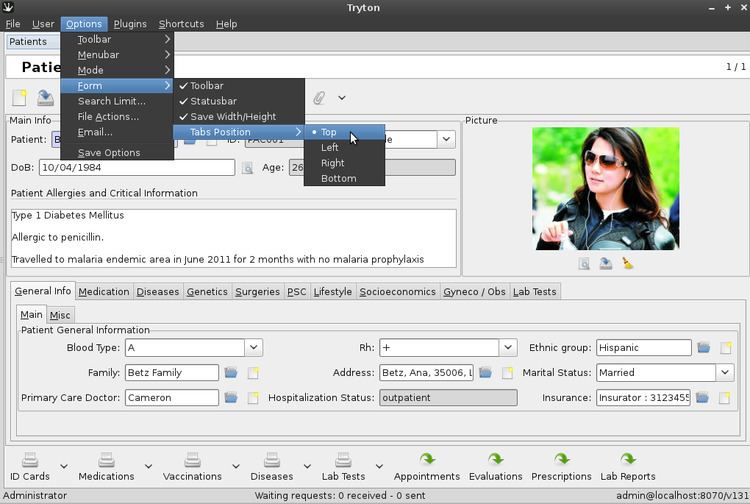Repository hg.tryton.org/trytond | Development status Active | |
 | ||
Developer(s) Cédric Krier and the Tryton community Initial release 17 November 2008; 8 years ago (2008-11-17) Stable release 4.2 / 28 November 2016; 3 months ago (2016-11-28) Preview release 4.0 / 2 May 2016; 10 months ago (2016-05-02) | ||
Tryton is a three-tier high-level general purpose computer application platform on top of which is built an Enterprise resource planning (ERP) business solution through a set of Tryton modules. The three-tier architecture consists of the Tryton client, the Tryton server and the Database management system (mainly PostgreSQL).
Contents
License
The platform, along with the official modules, are Free software, licensed under the GPLv3.
Modules and functional coverage
The official modules provide a coverage of the following functional fields:
Technical features
The client and the server applications are written in Python, the client uses GTK+ as graphical toolkit. Both are available on Linux, OS X, and Windows. A web client also exists written in Javascript using jQuery and Bootstrap and is named sao.
The kernel provides the technical foundations needed by most business applications. However it is not linked to any particular functional field hence constituting a general purpose framework:
Being a framework, Tryton can be used as a platform for the development of various other solutions than just business ERPs. A very prominent example is GNU Health, a free Health and Hospital Information System based on Tryton.
Origin and history
Tryton's origin is a fork of the version 4.2 of TinyERP (which was later called OpenERP and now renamed Odoo; Comparison of Tryton and Open ERP). The first version was published in November 2008
Project management & governance
In contrast to their parent project and other open-source business software, the Tryton founders avoided creating a partner network which tends to generate opposition and duality between the partners and the community of volunteers. They followed the PostgreSQL example where the project is driven by a federation of companies. As of August 2015, Tryton is supported by 17 of such companies, which are distributed globally as follows: France 3, Spain 3, Colombia 2, Germany, 2, Argentina 1, Australia 1, Belgium 1, Brazil 1, India 1, Mexico 1, Switzerland 1.
As of December 2012, the project is backed by Tryton, a Belgian private foundation pursuing a disinterested purpose. The foundation's missions are:
The release process is organised around series. A series is a set of releases with the same two first numbers (e.g. 1.0 or 1.2) that shares the same API and the same database scheme. A new series appears every six months and new versions in older release are introduced when bugfixes are available.
Name
The name Tryton refers to Triton, a mythological Greek god (son of Poseidon, god of the sea, and Amphitrite, goddess of the sea) and Python, the implementation language.
